Henry Clay Worksheets
Do you want to save dozens of hours in time? Get your evenings and weekends back? Be able to teach about Henry Clay to your students?
Our worksheet bundle includes a fact file and printable worksheets and student activities. Perfect for both the classroom and homeschooling!
Resource Examples
Click any of the example images below to view a larger version.
Fact File
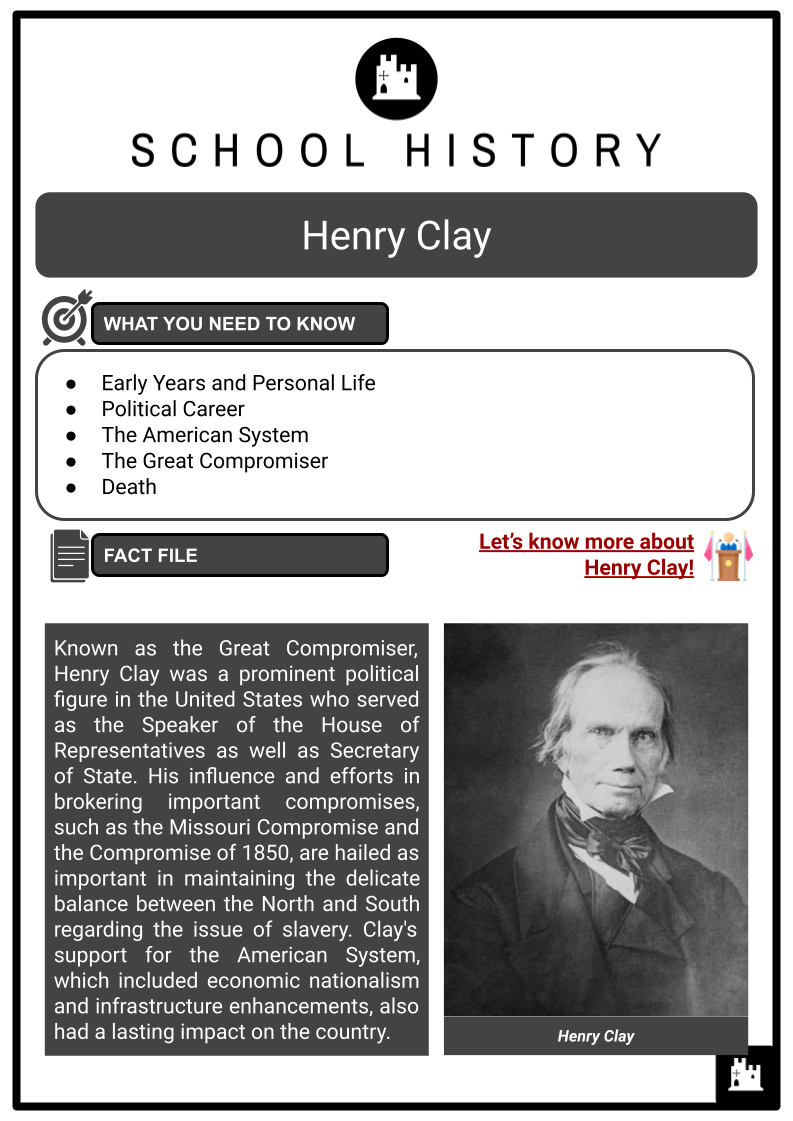
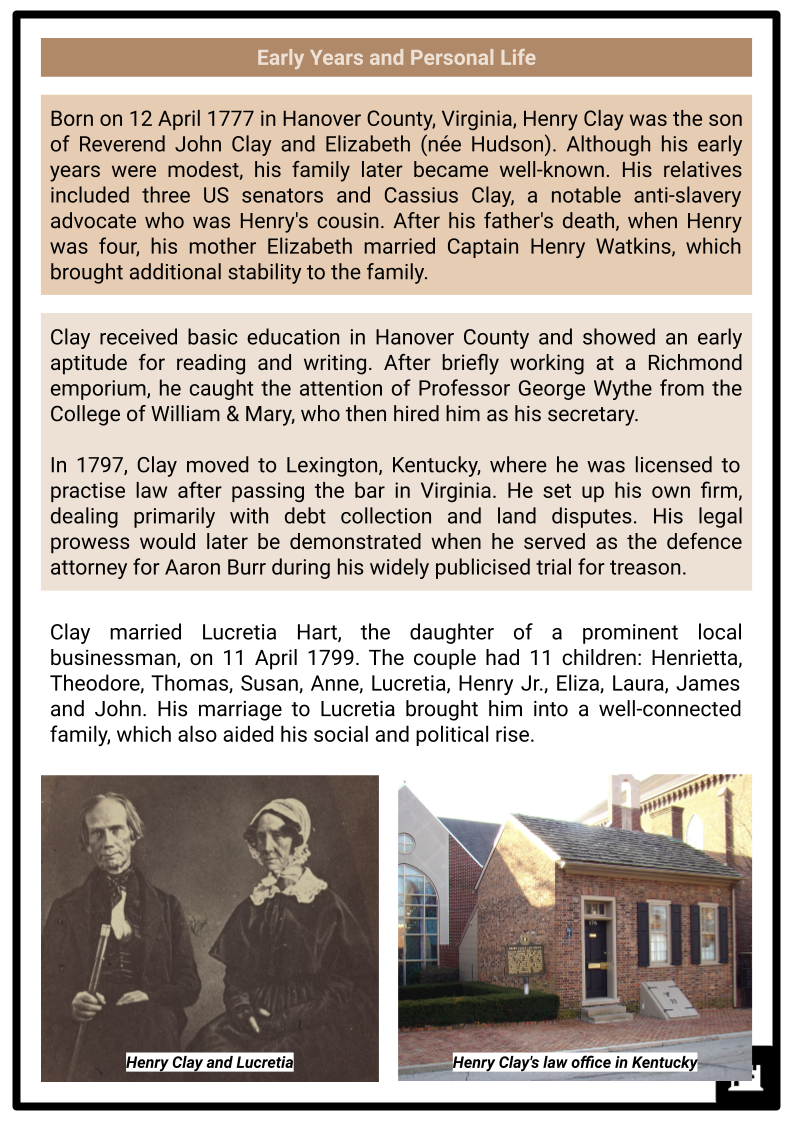
Student Activities
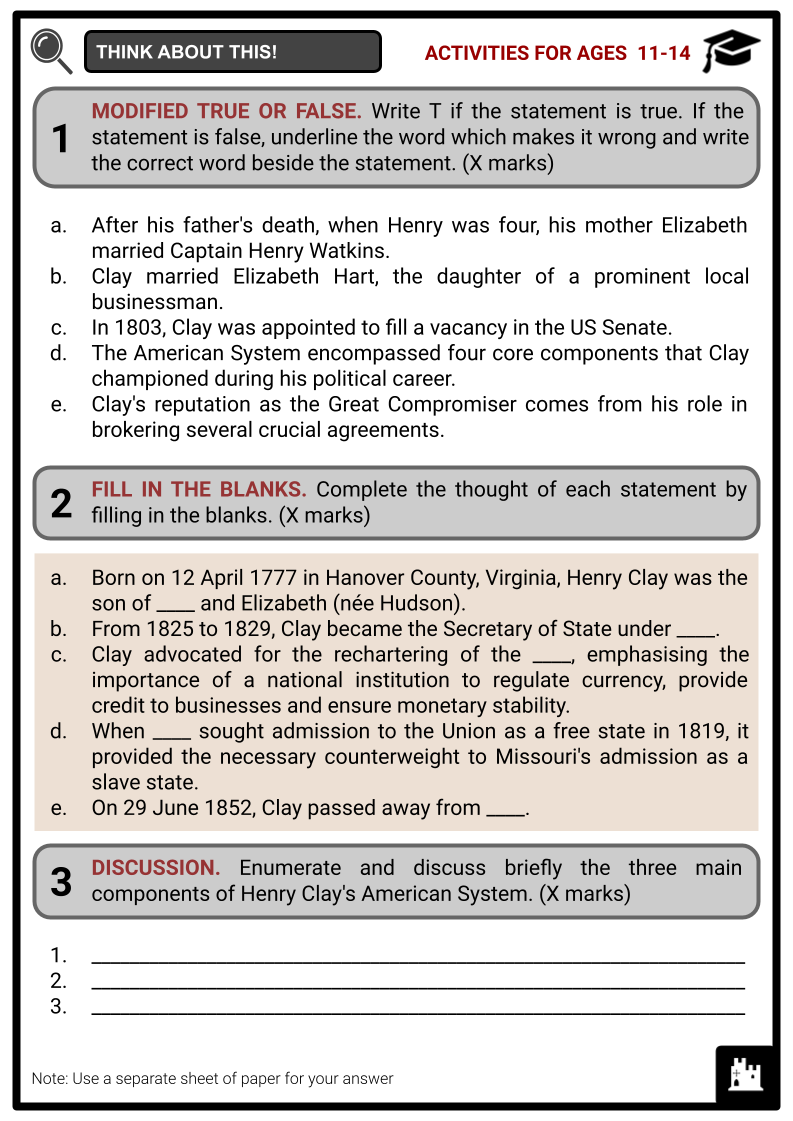
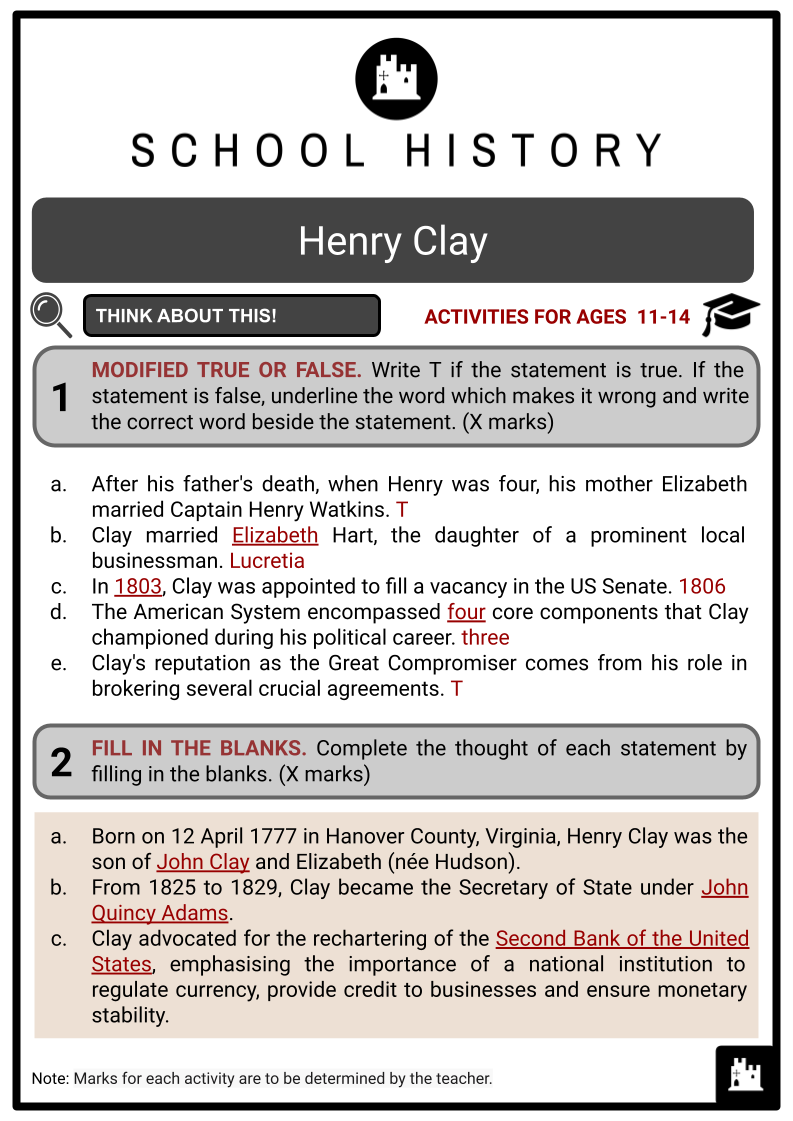
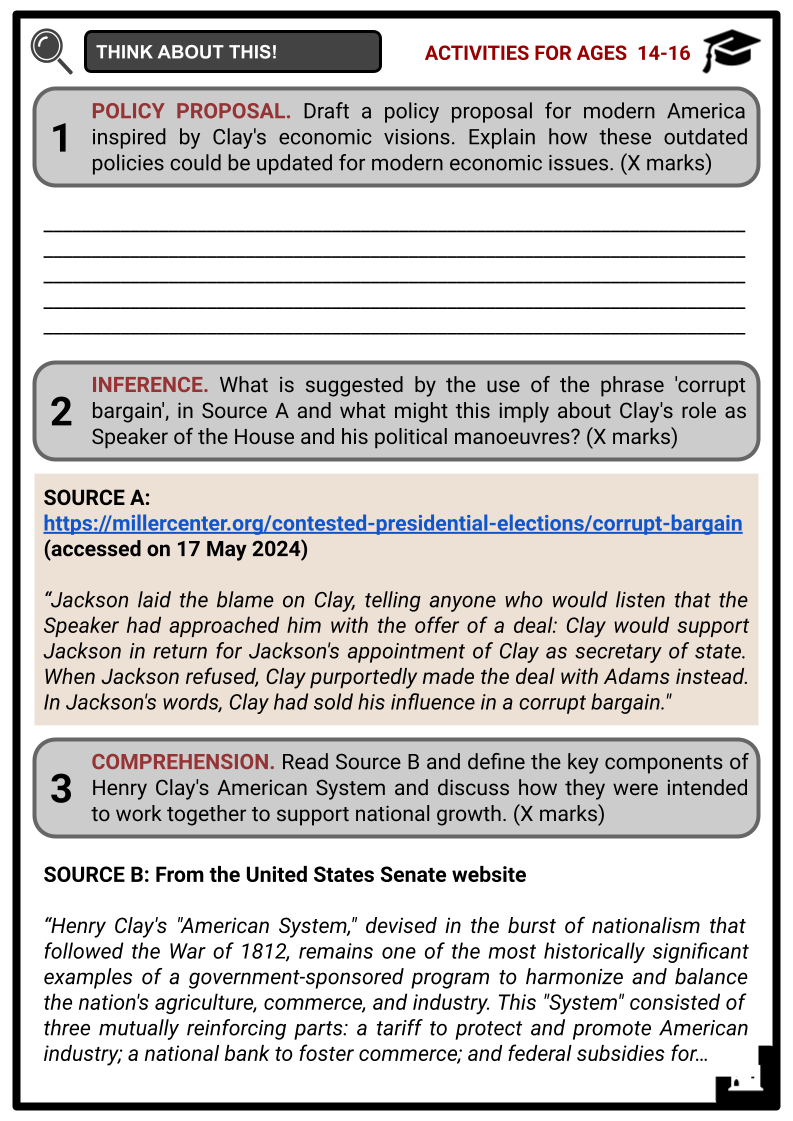
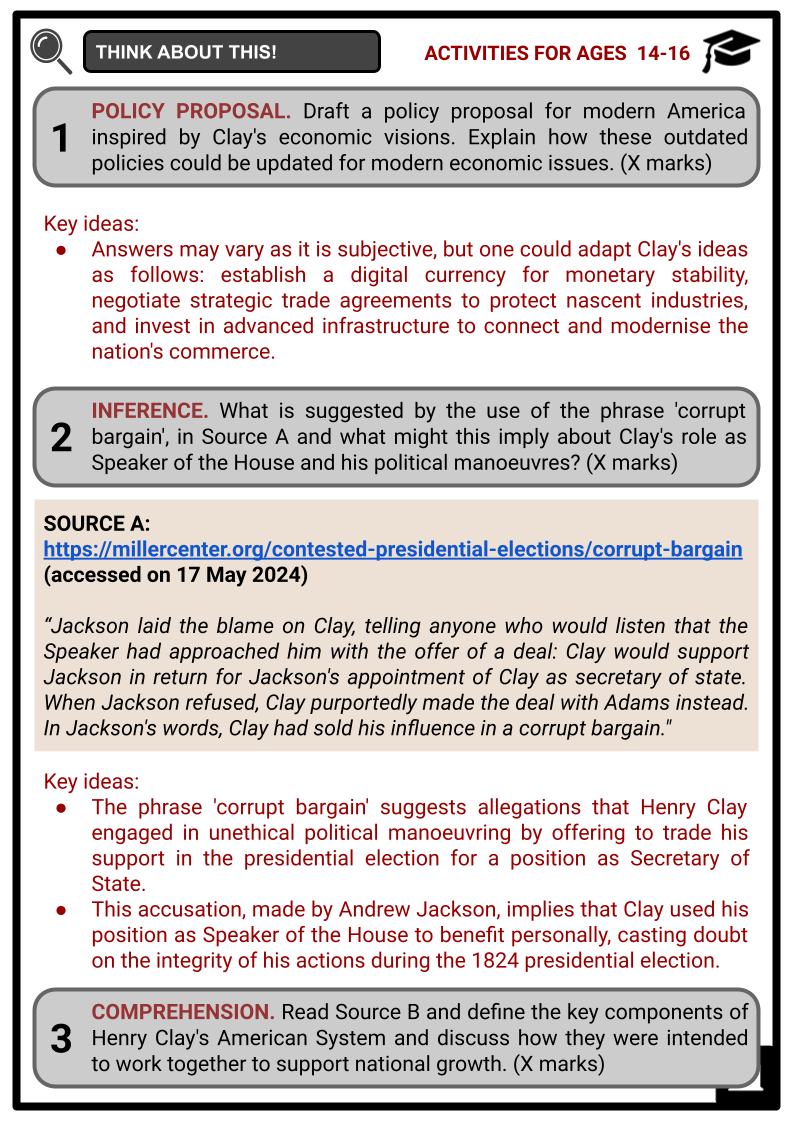
Summary
- Early Years and Personal Life
- Political Career
- The American System
- The Great Compromiser
- Death
Key Facts And Information
Let’s know more about Henry Clay!
Known as the Great Compromiser, Henry Clay was a prominent political figure in the United States who served as the Speaker of the House of Representatives as well as Secretary of State. His influence and efforts in brokering important compromises, such as the Missouri Compromise and the Compromise of 1850, are hailed as important in maintaining the delicate balance between the North and South regarding the issue of slavery. Clay's support for the American System, which included economic nationalism and infrastructure enhancements, also had a lasting impact on the country.
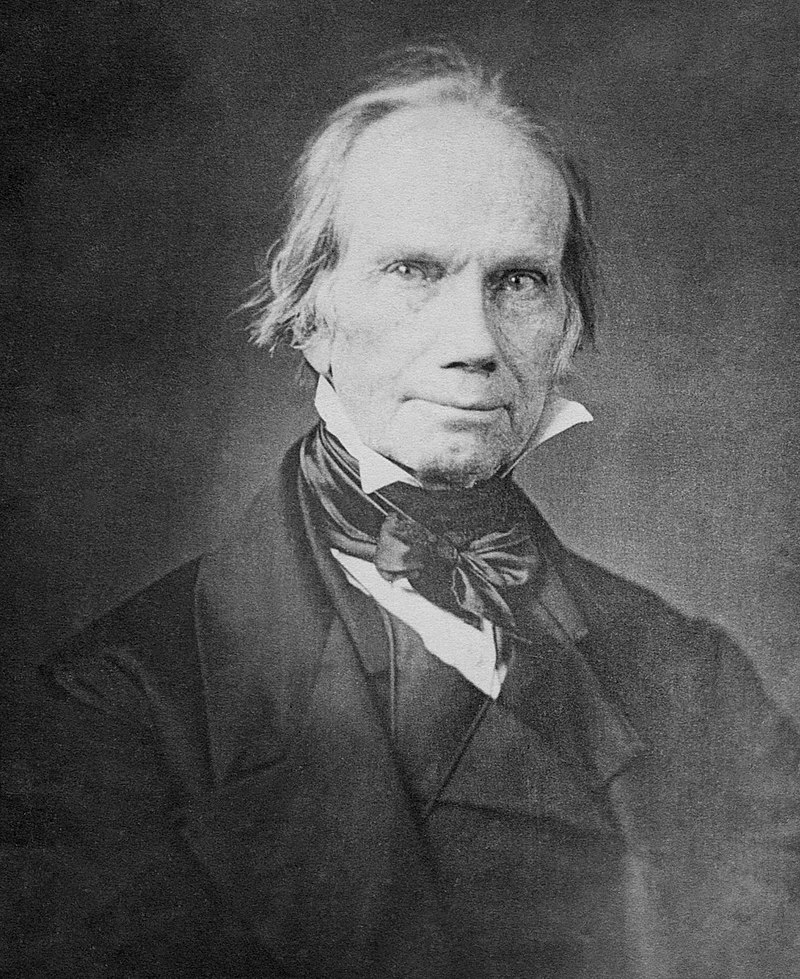
Early Years and Personal Life
- Born on 12 April 1777 in Hanover County, Virginia, Henry Clay was the son of Reverend John Clay and Elizabeth (née Hudson). Although his early years were modest, his family later became well-known. His relatives included three US senators and Cassius Clay, a notable anti-slavery advocate who was Henry's cousin. After his father's death, when Henry was four, his mother Elizabeth married Captain Henry Watkins, which brought additional stability to the family.
- Clay received basic education in Hanover County and showed an early aptitude for reading and writing. After briefly working at a Richmond emporium, he caught the attention of Professor George Wythe from the College of William & Mary, who then hired him as his secretary.
- In 1797, Clay moved to Lexington, Kentucky, where he was licensed to practise law after passing the bar in Virginia. He set up his own firm, dealing primarily with debt collection and land disputes. His legal prowess would later be demonstrated when he served as the defence attorney for Aaron Burr during his widely publicised trial for treason.
- Clay married Lucretia Hart, the daughter of a prominent local businessman, on 11 April 1799. The couple had 11 children: Henrietta, Theodore, Thomas, Susan, Anne, Lucretia, Henry Jr., Eliza, Laura, James and John. His marriage to Lucretia brought him into a well-connected family, which also aided his social and political rise.
Political Career
- Henry Clay made numerous contributions to American politics throughout his career, from his early years as a Kentucky state legislator to his influential role as Speaker of the House of Representatives and later as a diplomat. His impact on the nation's development was significant.
1803: Elected to the Kentucky General Assembly
- After establishing himself as a prominent lawyer in Lexington, Henry Clay entered politics and was elected to the Kentucky General Assembly in 1803. This marked the beginning of his political career.
- During his tenure in the Kentucky General Assembly, Clay advocated for policies that aimed to improve infrastructure, expand educational opportunities, and promote economic growth in the state. His efforts to champion the interests of the common people and his vision for a prosperous and united Kentucky earned him widespread admiration and support.
1806: Appointed to fill a vacancy in the US Senate
- In 1806, Clay was appointed to fill a vacancy in the US Senate. As a Senator, he continued to champion his vision for economic growth and infrastructure development, advocating for policies that aimed to benefit not only his home state of Kentucky but also the nation as a whole. His strategic thinking and persuasive rhetoric, which had gained him widespread admiration and support at the state level, now had a platform to influence national politics.
1811: Became the Speaker of the US House of Representatives
- Clay's influence in American politics continued to grow, and in 1811, he was elected as the Speaker of the US House of Representatives. As the Speaker, he used his oratory and political skills to effectively lead the House, often navigating contentious debates and shaping legislative agendas.
- Notably, his tenure saw him align with the War Hawks, young congressmen who advocated for a more aggressive stance against British infractions on American sovereignty, ultimately contributing to the outbreak of the War of 1812. He was also influential in advancing key economic policies aimed at stimulating national growth and working toward the resolution of sectional disputes.
1824: Ran for the presidency but lost
- In 1824, Clay ran for the presidency of the United States. The election was a contentious one, and Clay faced strong competition from other candidates. Despite his influential political career and significant contributions to American politics, he was unable to secure the presidency in the 1825 election.
- The election resulted in a complex outcome, with no candidate receiving a majority of the electoral votes.
- The decision was then referred to the House of Representatives, where Clay, as Speaker at the time, took part in the selection of John Quincy Adams as the sixth President of the United States. This decision was met with controversy and accusations of a 'corrupt bargain', as Adams then appointed Clay as his Secretary of State.
- In his subsequent attempts at the presidency, Henry Clay ran for office in 1832, 1844 and 1848 but was never able to secure the position.
1825: Served as Secretary of State
- From 1825 to 1829, Clay became the Secretary of State under President John Quincy Adams. During his tenure, he focused on advancing diplomatic relations with other nations, particularly in the Western Hemisphere. He pursued policies aimed at strengthening trade agreements, expanding the nation's influence in the Americas, and advocating for the principles of non-intervention and self-determination.
- One of Clay's notable initiatives as Secretary of State was his emphasis on promoting the economic and strategic interests of the United States in Latin America. He recognised the potential for mutually beneficial partnerships with nations in the region and sought to cultivate and maintain friendly relations through diplomatic negotiations and trade agreements.
- Clay's time as Secretary of State was characterised by his dedication to supporting the principles of American independence and territorial integrity. He adeptly handled challenging global situations and discussions with a sharp emphasis on safeguarding the country's interests while seeking peaceful solutions to possible disputes.
1831: Elected to the US Senate
- After his tenure as Secretary of State, Clay was elected to the US Senate in 1831, marking a return to legislative leadership at the national level. His return to the Senate allowed him to champion his vision for economic development, advocate for the preservation of the Union, and engage in critical debates on the pressing issues of the time.
1849: Senator of Kentucky
- In 1849, Clay was again elected to the US Senate, reaffirming his enduring influence and dedication to public service. His return to the Senate provided an opportunity to contribute to discussions on pressing national issues.
The American System
- Clay's legacy in American politics is significantly marked by his advocacy for the American System, a comprehensive economic plan aimed at fostering national growth and unity. Clay's vision for economic development and infrastructure was grounded in the belief that a strong, self-sufficient national economy was essential for the prosperity and stability of the United States.
- The American System encompassed three core components that Clay championed during his political career: a national bank to regulate and stabilise the currency, a protective tariff to promote domestic manufacturing, and internal improvements such as transportation infrastructure to connect the various regions of the country. Clay tirelessly promoted these policies, seeing them as vital to economic progress and the preservation of the Union.
The National Bank: Promoting Financial Stability
- Central to the American System was the establishment of a national bank, which Henry Clay viewed as an indispensable instrument for managing the country's finances and promoting stable economic growth. He advocated for the rechartering of the Second Bank of the United States, which originally had a 20-year charter from 1816 to 1836, emphasising the importance of a national institution to regulate currency, provide credit to businesses, and ensure monetary stability. Clay argued that a national bank would prevent financial chaos, encourage investment, and facilitate the implementation of other components of the American System.
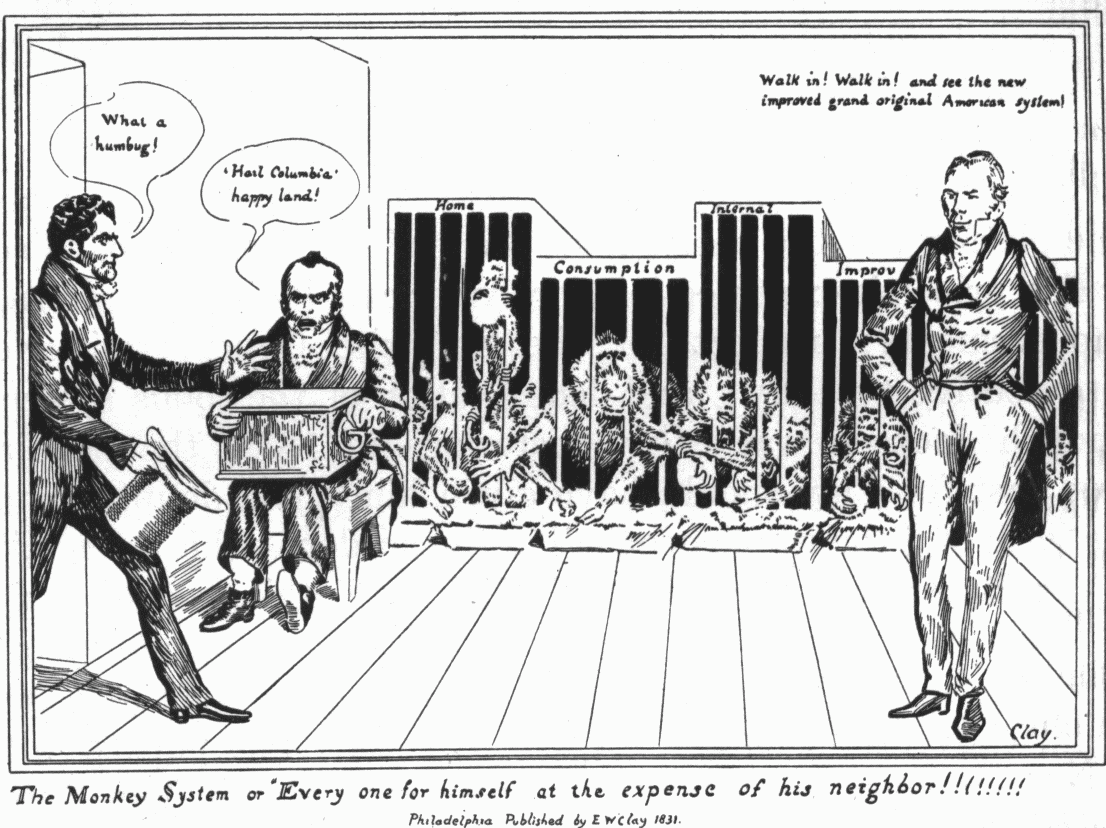
Protective Tariffs: Fostering Domestic Industry
- In line with his vision for economic self-sufficiency, Clay advocated for protective tariffs to shield American industries from foreign competition and nurture domestic manufacturing. He supported the Tariff of 1816, which was the first truly protective tariff, and also backed the Tariff of 1824 and the even higher Tariff of 1828, known as the Tariff of Abominations. He believed that by imposing tariffs on imported goods, the United States could create a level playing field for its own producers, stimulate industrial growth, and reduce dependence on foreign products. His advocacy for protective tariffs was intended to strengthen the country's economic self-reliance and improve its position as a manufacturer and seller of products.
Internal Improvements: Connecting the Nation
- Recognising the importance of efficient transportation and communication networks for national cohesion and economic progress, Clay endorsed internal improvements such as the construction of roads, canals and other infrastructure projects during the early to mid-1800s. He was a strong proponent of the National Road, started in 1811, and other significant ventures like the Erie Canal, completed in 1825. He saw these initiatives as crucial for connecting different regions, facilitating trade and commerce, and promoting the development of the country's vast resources.
- While the complete implementation of the American System faced challenges and encountered opposition from various quarters, its principles and objectives continued to shape debates on economic development, trade and infrastructure in the decades following Clay's political career.
The Great Compromiser
- The hallmark of Clay's political career was his ability to navigate a path through obstacles that seemed insurmountable and unite opposing groups. His reputation as the Great Compromiser comes from his role in brokering several crucial agreements, primarily the Missouri Compromise of 1820 and the Compromise of 1850, which influenced the course of American history.
Missouri Compromise of 1820
- As the United States grappled with the divisive issue of slavery following the American Revolution, the effort to maintain a balance between free and slave states became a pressing concern. The Missouri Territory's 1817 petition for statehood – as a slave state – posed a significant challenge to this balance.
- During the ensuing congressional sessions, Northern representatives like James Tallmadge proposed measures to restrict slavery in Missouri, but were met with resistance from Southern legislators. Clay's approach to resolving the situation involved a series of legislative manoeuvres that facilitated a middle ground.
- When Maine sought admission to the Union as a free state in 1819, it provided the necessary counterweight to Missouri's admission as a slave state. Clay's management of the legislative process guaranteed that each state's admission moved forward independently in Congress, preventing a deadlock.
- Furthermore, his strategic alignment with proposals like Senator Jesse Thomas's amendment, which stipulated the exclusion of slavery from the Louisiana Purchase territories north of latitude 36°30′, helped forge a broader, more sustainable agreement.
- Ultimately, under Clay's guidance, Congress reached a resolution in March 1820 – the Missouri Compromise. It permitted Maine's entry as a free state, Missouri's entry as a slave state, and the restriction of slavery in new territories to the north. The Kansas–Nebraska Act of 1854 and the Dred Scott decision of 1857 later challenged and ultimately undid the Compromise.
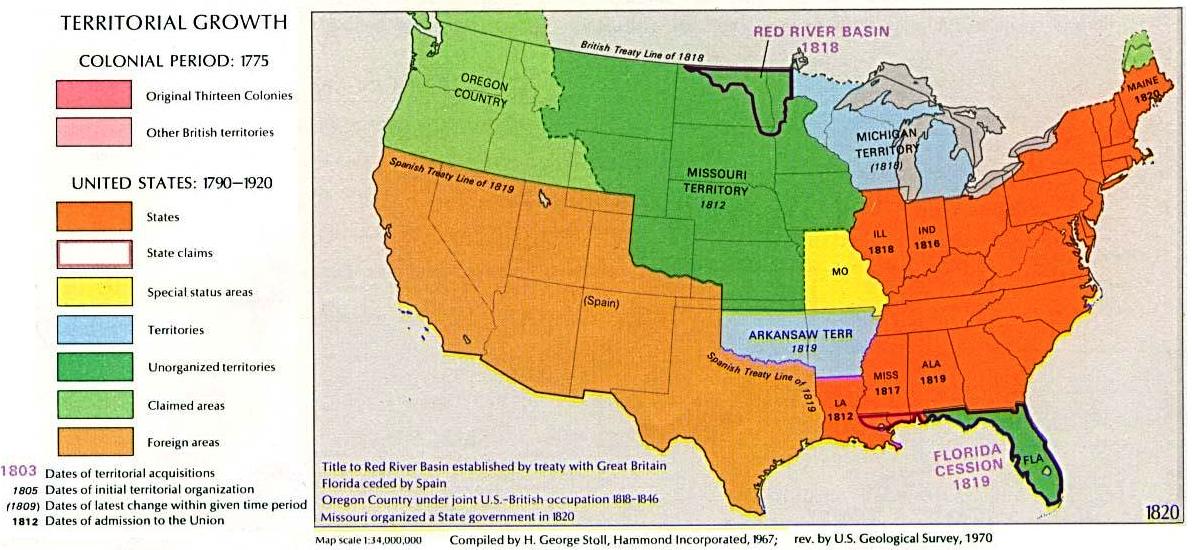
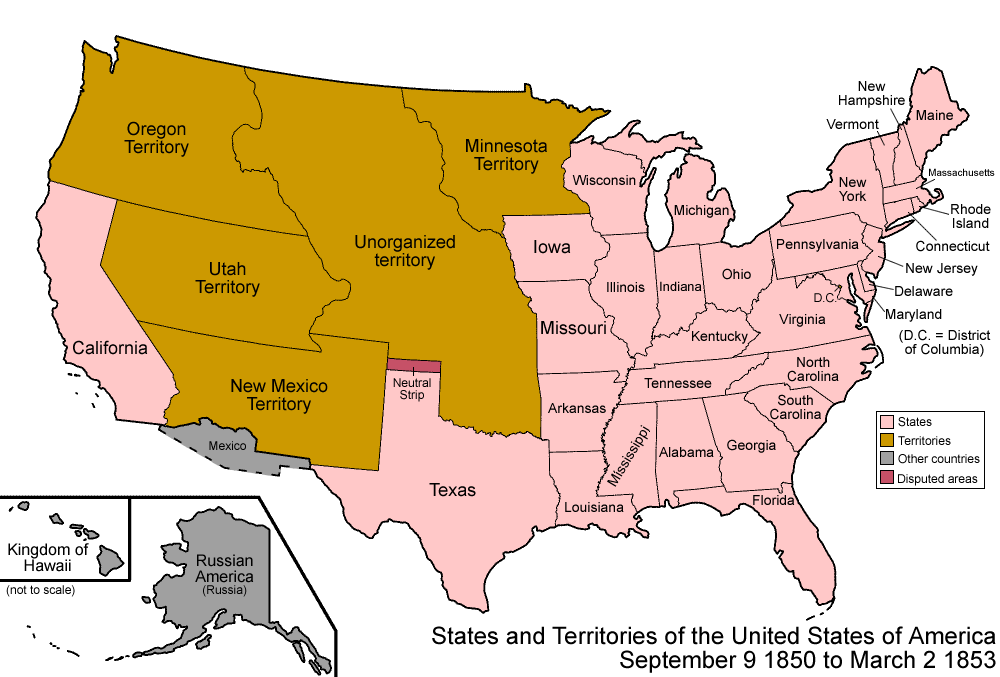
Compromise of 1850
- The year 1846 saw the proposal of the Wilmot Proviso by Democratic Congressman David Wilmot, which sought to ban slavery in any territory acquired from Mexico. This amendment sparked an enduring conflict between the North and South, setting the stage for the struggle over slavery and westward expansion.
- Amid this political climate, the discovery of gold in California accelerated the need for a swift resolution. As California sought admission to the Union as a free state, the potential disruption to the balance between free and slave states heightened tensions.
- Clay rose to the occasion with a series of legislative proposals aimed at defusing the situation. Known as the Compromise of 1850, his solutions sought a middle ground: they called for the admission of California as a free state, the establishment of territorial governments in the rest of the lands acquired from Mexico (with the question of slavery to be decided by popular sovereignty), the settlement of the Texas boundary dispute, the abolition of the slave trade (but not slavery itself) in Washington, D.C., and the introduction of a stricter fugitive slave law to appease southern states.
- Clay's groundwork and the subsequent presidency of Millard Fillmore allowed these measures to be enacted, albeit individually rather than as a single bill. Through his skill in making laws and a strong dedication to finding common ground as a way to maintain the unity of the country, Clay was able to temporarily ease the regional conflict.
Death
- In December 1851, recognising the toll that years of public service and declining health were taking on his body, Henry Clay, then 74 years old, announced his intention to resign from the US Senate the following September. However, he would not see that date, as his health rapidly deteriorated.
- In his suite at the National Hotel in Washington, D.C., on 29 June 1852, Clay passed away from tuberculosis. His death signified the end of an influential chapter in American political history. As a measure of the nation's respect for his contributions, Clay was the first American to lie in state in the United States Capitol rotunda.
- Numerous dignitaries, politicians and citizens who had admired his commitment to the Union and his skill in influencing the nation's legislative framework attended his funeral, which was a national event. The eulogies delivered in the wake of his passing often centred on his role as a compromiser and his devotion to service.
Image Sources
- https://upload.wikimedia.org/wikipedia/commons/thumb/c/c9/Henry_Clay_1848_restored.jpg/800px-Henry_Clay_1848_restored.jpg
- https://upload.wikimedia.org/wikipedia/commons/b/b6/Henry_Clay_-_Project_Gutenberg_eText_16960.png
- https://upload.wikimedia.org/wikipedia/commons/3/3f/USA_Territorial_Growth_1820_alt.jpg
- https://upload.wikimedia.org/wikipedia/commons/4/40/United_States_1850-1853-03.png
Frequently Asked Questions
- Who was Henry Clay?
Henry Clay was an American statesman and political leader who served as a congressman, senator, and Speaker of the House.
- What were some of Henry Clay's notable achievements?
Clay was known as the "Great Compromiser" for brokering several major legislative compromises, including the Missouri Compromise and the Compromise of 1850.
- Did Henry Clay run for President?
Yes, Henry Clay ran for President multiple times but was unsuccessful in winning the office. He ran in the presidential elections of 1824, 1832, and 1844.
